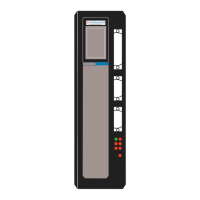35
CD1-a
Chapter 6 - Commissioning
In case of loud noise in the motor at standstill and when running, check the rigidity of the transmission
between motor and load (backlashes and elasticities in gears and couplings). If necessary, start the Auto-
tuning procedure while selecting a lower bandwidth. If the problem remains, renew the Auto-tuning while
activating the antiresonance filter.
♦ Start the Offset compensation function or start the offset compensation by means of the Offset push- button
on the amplifier front panel.
♦ Check that the motor is correctly running in both directions in mode Digital speed input command. If
necessary, readjust the speed regulator parameters by means of the Stability button.
3.3 - SPEED LOOP ADJUSTMENT WITH VERTICAL LOAD
Start the Auto-tuning procedure with the motor uncoupled from its mechanical load in order to initialize the
speed loop gains. Select the limiting mode of the I
2
t function (see chapter 8, section 3.2). Then select the speed
regulator (PI or PI
2
). Couple the motor to the load again and move the shaft by means of the digital speed input
command until its maintaining position where the shaft rotation over one revolution is not dangerous for
operator and machine.
Then execute the Auto-tuning command with the motor enabled at its maintaining position (zero speed input
command). In case of loud noise in the motor at standstill and when running, check the rigidity of the transmission
between motor and load (backlashes and elasticities in gears and couplings). If necessary, start the Auto-tuning
procedure while selecting a lower bandwidth. If the problem remains, renew the Auto-tuning while activating the
antiresonance filter.
3.4 - AMPLIFIER PARAMETERS SAVING
Save all parameters in the amplifier EEPROM by means of the function Parameters saving in the EEPROM.

